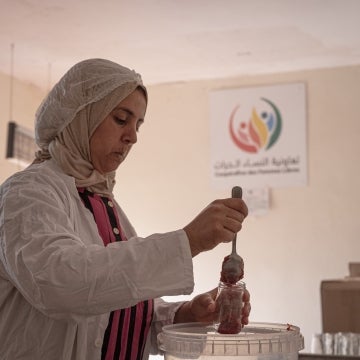Morocco is taking a bold step to transform its financial system into a true enabler of women’s economic empowerment. In partnership with CGAP, Bank Al-Maghrib and the Ministry of Economy and Finance are in the process of launching a “Women’s Financial Inclusion (WFI) Coalition”. Embedded within the governance of Morocco’s upcoming next phase of the National Financial Inclusion Strategy (NFIS), the coalition is designed to drive systemic, coordinated, and lasting impact.
This is more than another task force – it signifies a shift in how countries can mobilize a range of stakeholders to close gender gaps in finance.
The paradox: Robust infrastructure, persistent gaps
Morocco has made significant strides in building a robust financial infrastructure — including a strong national ID system, an interoperable payment network, and a sound regulatory framework. Morocco also launched several initiatives to trigger demand for formal financial services, such as promoting account-based cash transfer programs, providing tax incentives for merchants accepting digital payments, and implementing large financial education programs.
Despite these advances, Morocco continues to face one of the widest gender gaps in financial inclusion . The gender gap in financial account ownership stands at 20 percentage points, four times the 5-percentage point average for developing economies. In 2024, only 35% of adult women in Morocco held an account with a financial institution, compared to 55% of men.
Why this paradox? Multidimensional barriers, fragmented responses
Morocco’s high gender gap in financial inclusion stems from deep, interconnected barriers that limit women’s demand for services and shape what’s offered. Financial service providers report two main challenges: low demand, as many women view formal finance as irrelevant due to low or irregular incomes, limited labor force participation (under 20%), and reliance on cash or husbands’ accounts; and complex demand, since women, especially in rural areas, face lower financial and digital literacy, administrative hurdles, and mobility constraints. These challenges are reinforced by social norms that restrict women’s economic roles and independence, further limiting access and participation in financial services.
These factors contribute to a market dynamic where FSPs see serving women as socially important, but commercially uncertain. The high upfront investments, marginal returns, and low historical uptake have led many private sector actors that to view women as a low-priority customer segment. As a result, FSPs often underutilize available data to design tailored services and delivery channels.
Financial inclusion efforts in the past often addressed demand or supply issues in isolation, tackling only parts of the problem without systematically sharing insights or leveraging global experience. This fragmented approach has limited both scale and sustainability. What’s needed is a coordinated system that aligns actors, connects local and global learning, and drives cumulative progress toward sustainable inclusion for women.
Recognizing this, Moroccan financial authorities, with CGAP’s support, have embedded women’s inclusion in the updated NFIS and launched a national coalition for WFI to advance women’s economic empowerment. Led by financial sector authorities, the coalition brings together actors from the financial sector (including key banks, MFIs, and payment companies), other public sector actors (including allied ministries), as well as professional associations and will receive support from donors. It coordinates initiatives, addresses critical gaps, and mobilizes private sector participation to pilot and scale impactful interventions.
What will the coalition do differently? Five core principles
The coalition brings together ambition and action, diagnosis and delivery, policy and practical support, following five core principles.
1. Setting a clear national goal for women’s financial inclusion
Women are not only a broad priority group—they will be an explicit target of the new NFIS, with specific gender goals embedded in national commitments, such as increasing women’s financial account ownership from 35% toward a higher benchmark . This focus makes WFI a measurable benchmark of success, creating urgency, strengthening accountability, and driving intentional action. It also aligns financial sector authorities with private sector actors, including banks, payment providers, and microfinance organizations, enabling stakeholders to work collectively through coalition-led workshops, pilot initiatives, and shared learning tools to advance WFI.
2. Aligning policy and practice for greater impact
This coalition goes beyond building enablers—it ensures the ecosystem uses them to deliver for women. Instead of a linear path from diagnostics to reforms to results, it promotes a continuous cycle where reforms drive pilots and field insights inform policy adjustments. A core group of ministries, the central bank, and industry networks set direction, while a broader network of financial institutions and infrastructure operators pilot innovations and feed lessons back into strategy.
The strong private sector role is distinctive, anchoring the coalition’s focus on practical outcomes. As challenges arise, members work collectively to remove obstacles, direct funding where needed, and share system-level lessons that keep the coalition agile and results-driven.
3. Providing hands-on support to turn commitments into action
The coalition is designed to engage, not just coordinate. FSPs, regulators, ministries, and donors. Beyond coordination, it provides practical, targeted support to help members implement their roadmaps for reaching more women and expanding offerings for existing women customers. By focusing on what members need to move from intention to action through piloting and scaling women-focused interventions the coalition addresses a common challenge in working groups: member disengagement.
Support will be provided at three levels: system, cross-member, and institution-level. At the system level, the coalition gathers field insights, identifies constraints, and suggests reforms through shared diagnostics, knowledge sharing from international experiences, and in-country gap-mapping. Cross-member support fosters collaboration and peer learning, while at the institutional level, members receive targeted mentoring and connections to partners. For example, the coalition’s first initiative aims to equips FSPs with data and behavioral insights tools to design services tailored to women. These tools will be shared broadly with all members, while the coalition facilitator might provide tailored guidance for FSPs, and elevate regulatory or infrastructure barriers to the core group for system-level action.
4. Designing pathways for different groups of women
The coalition will support its members in charting progressive pathways for priority segments of women — recognizing that financial inclusion is not achieved through a single service or intervention, but through a sequence of steps that build readiness, trust, and value over time.
These pathways will combine both financial service interventions (e.g., account opening, tailored savings, improved agent networks) and non-financial interventions, often requiring collaboration beyond the financial sector (e.g., workplace engagement, retailer partnerships for digital payments). By building pathways that reflect the actual journeys women take and that activate the enablers they need at each stage, FSPs can design more effective solutions
5. Coordinating the coalition and sustaining momentum
CGAP will act as a facilitator, at least for the first year. As the facilitator, we’ll coordinate strategy, monitor progress, and actively support members. This will ensure that momentum is sustained beyond group meetings and keep the coalition on track. We will also map funding needs and coordinate efforts to secure support for key activities. Development partners will be engaged from the outset, through regular updates and structured collaboration opportunities.
From siloed efforts to scale: Driving market-level change
If we want to build financial systems that work for women, we need to move beyond asking financial service providers to do it alone. Lasting change requires coordinated action, continuous learning, and shared accountability.
By setting bold ambitions to reach more women at scale, breaking silos, and uniting diverse actors around a shared goal, Morocco’s WFI coalition could set a new benchmark for closing gender gaps in finance. In the months ahead, we will share insights from its journey and lessons for building gender-inclusive financial systems



